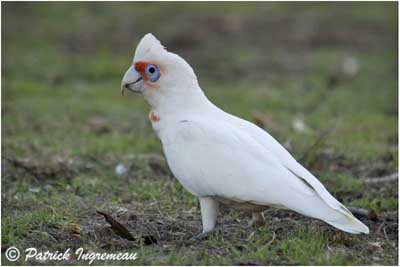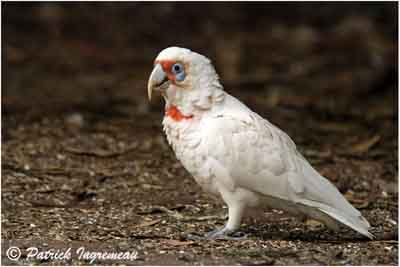
Long-billed Corella
Cacatua tenuirostris
Psittaciforme Order – Cacatuidae Family
BIOMETRICS :
Length : 38 à 41 cm
Wingspan : 80 à 90 cm
Weight : 565 à 640 g
DESCRIPTION:
Long-billed Corella is a lovely cockatoo with white plumage, native of south eastern Australia. First record was by Kuhl, in 1820s.
Long-billed corella adult has white plumage. Undertail and underwings are suffused pale yellow, very conspicuous in flight. It has red colouring on throat and breast, with a neat red crescent on upper breast.
White head shows white small crest. We can see red forehead and lores. A broad, bare, blue-grey fleshy eye-ring is around the dark brown eyes. Bill is white with washed bluish base. Upper mandible is long and hooked. Legs and feet are dark grey.
Female is similar to male, with shorter upper mandible and less red colour.
Juvenile resembles adults but it is duller, with less red markings and shorter bill.
Fr: Cacatoès nasique
All : Nasenkakadu
Esp : Cacatúa Picofina
Ital : Corella beccolungo
Nd : Langsnavelkaketoe
Russe : Длинноклювый Какаду
Photographs by Patrick Ingremeau
TAMANDUA
Text and pictures of the captive bird by Nicole Bouglouan
Sources:
PARROTS OF THE WORLD – An Identification Guide – by Joseph M. Forshaw – Princeton University Press – ISBN 0691092516
HANDBOOK OF THE BIRDS OF THE WORLD vol 4 by Josep del Hoyo-Andrew Elliott-Jordi Sargatal - Lynx Edicions - ISBN: 8487334229
Avibase (Lepage Denis)
Wikipedia (Wikipedia, The Free Encyclopedia)
Birds in backyards (Birds Australia and Australian Museum)

There are two similar species:
Little Corella (Cacatua sanguinea). It lacks red forehead and red colour in fore neck, and upper mandible is shorter.
Sulphur-crested Cockatoo (Cacatua galerita), almost similar in flight, it has yellow crest and lacks red colour. Bill is black.
VOICE: SOUNDS BY XENO-CANTO
Long-billed Corella utters a loud, quavering “curr-ur-rup…curr-ur-rup” contact call in flight. It also gives harsh, abrupt “screech” when alarmed.
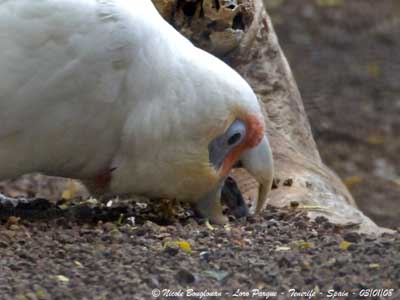
HABITAT:
Long-billed Corella is common in woodlands and remnant trees in farmlands. It nests in Eucalyptus camaldulensis in flood plains or near streams. Feral populations live in farmlands and parks in urban areas.
RANGE:
Long-billed Corella lives in far south-eastern South Australia.
BEHAVIOUR:
Long-billed Corella feeds mainly on ground. It feeds on grass seeds, using its long upper mandible to dig up seeds, roots and bulbs. While feeding, one bird remains in a tree for watching around. They feed in the cooler hours of the day, and they rest in shade at midday.
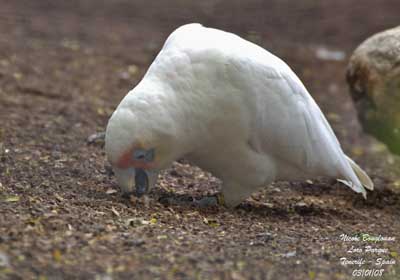
It is resident in its range, performing some local movements. Outside breeding season, it may be seen in large flocks of up to 2000 birds or more. They are noisy and conspicuous, uttering discordant calls.
They roost in large Eucalypts near water. They leave the roost at dawn for drinking, and then, they go to feeding areas. They return to roost at dusk. Before settling for the night at roosts, Long-billed Corella engages in excited acrobatics.
Long-billed Corella moves on the ground with stunning hopping motion. They don’t have the waddling gait of other cockatoo species.
It causes damage in cereal crops, and it is considered as pest of grain crops and fruit trees, and sometimes, they suffer shooting from farmers.
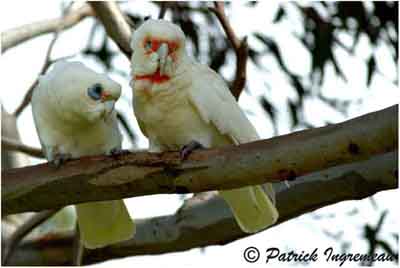
They nest in colonies in same trees. They can nest with other corella’s species, and sometimes, they hybridize. Feral populations in Sidney and Perth, coming from release of unwanted birds, may hybridize with the endangered species of Western Corella (Cacatua pastinator) which is a subspecies of Little Corella.
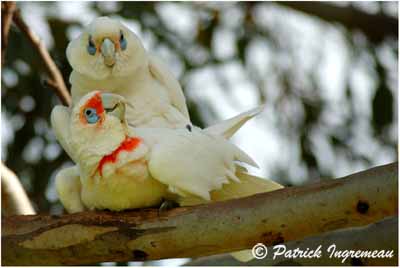
FLIGHT:
Long-billed Corella flies with rapid, flapping wing beats, sometimes interspersed with short glides on down curved wings.
REPRODUCTION:
Long-billed Corella breeds from July to November. They form monogamous pairs. Both adults prepare the nest. It is situated in hollow in tree, but if they don’t find suitable tree, they may make a burrow in soft dirt bank. Nest is lined with shavings of wood. It may be reused for several years. Long-billed Corella nests in large colonies, with several nests in the same tree.
Female lays 2 to 4 white eggs. Incubation lasts about 24 days, shared by both parents. Altricial chicks are fed by adults. They fledge about 55 days after hatching.
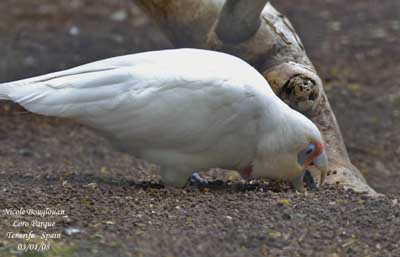
DIET:
Long-billed Corella feeds mainly on grass seeds, but also on bulbs and roots, particularly from the weed onion grass “Romulea”. It also consumes insects. It causes damage in grain crops and fruit trees.
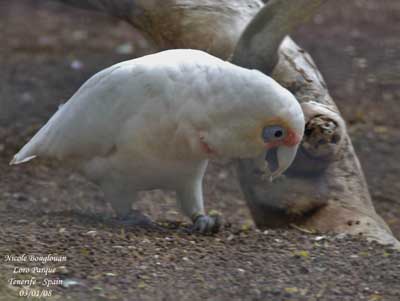
PROTECTION / THREATS / STATUS:
Long-billed Corella is considered as pest by farmers who shoot them as pest crops.
Populations may be in decline, due to loss of suitable nesting sites in its original range.
However, Long-billed Corella is common in its range. It is very popular as pet in most of Australia, and has been labelled the best “talker” of the Australian Cockatoos, with its ability to mimic words to near perfection.
